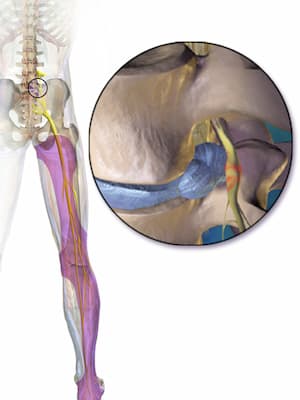
If you’ve ever felt sharp, shooting pain that runs from your lower back down into your leg, you’re not alone. Sciatica affects an estimated 10–40% of people during their lifetime, especially adults between the ages of 30 and 50.
For some, it’s an occasional nuisance. For others, it can be completely debilitating — leading to missed workdays, sleepless nights, and in severe cases, being confined to bed.
That’s why sciatica is more than “just back pain.” It’s one of the leading causes of lost work time worldwide and one of the most common reasons patients seek help from both medical doctors and chiropractors. For a closer look at how chiropractic compares to conventional sciatica treatments, see our related article on why chiropractic care is a strong alternative for sciatica relief.
At Back2Health Chiropractic in Omaha, chiropractor Dr. Jeffrey Meyers helps patients find lasting relief from sciatica — without medication or surgery
What Causes Sciatica?
Sciatica isn’t a condition by itself but a set of symptoms caused by irritation of the sciatic nerve — the body’s largest nerve. This nerve runs from the lower spine through the hips and down each leg. When something compresses or irritates it, you may feel pain, tingling, numbness, or weakness anywhere along its path.
Here are the three most common culprits:
Herniated Disc
The soft inner material of a spinal disc can bulge through its tougher outer layer and press on the sciatic nerve root. This is one of the most common causes of radiating leg pain.
Spinal Stenosis
A narrowing of the spinal canal, often related to aging, compresses nerve roots. Standing or walking often makes the pain worse.
Muscular Entrapment (Piriformis Syndrome)
The piriformis muscle, located deep in the buttock, can become tight and squeeze the sciatic nerve, producing symptoms that mimic classic sciatica.
How Bad Can It Get?
For some people, sciatica is a nagging ache that comes and goes. For others, it can be life-altering. Patients often report:
- Needing to miss work or cut back hours
- Difficulty sitting at a desk, driving, or standing in line
- Sleep disruption from pain or leg cramping
- Being bed-ridden for days or weeks during severe flare-ups
While many people improve over time, the key is finding a safe and effective care plan that addresses the root problem rather than simply masking symptoms.
Typical Medical Treatments
When patients visit a doctor’s office for sciatica, they are most likely to encounter:
- Medications – anti-inflammatories, muscle relaxants, or short courses of steroids to reduce pain and inflammation
- Physical Therapy – exercises to stretch tight muscles and strengthen the core
- Epidural Steroid Injections – cortisone shots around the nerve root for stubborn cases
- Surgery – reserved for severe cases (such as progressive weakness or bowel/bladder issues), procedures like microdiscectomy or laminectomy relieve nerve compression
While these treatments can help, they often focus on symptom management rather than correcting the underlying mechanical issue. Medications also carry the risk of side effects or dependency. That’s why many Omaha patients explore a chiropractic alternative for sciatica relief before resorting to more invasive procedures.
Why Chiropractic Care is Different
Chiropractic care offers a natural, drug-free path that aims to address the source of the problem:
- Spinal Adjustments restore motion, reduce nerve irritation, and improve alignment.
- Flexion-Distraction & Decompression techniques relieve pressure from herniated discs or pinched nerves.
- Soft Tissue Therapy relaxes tight muscles, such as the piriformis, that can compress the sciatic nerve.
- Corrective Exercises & Postural Coaching build long-term strength and mobility to help prevent recurrence.
By combining these approaches, chiropractors often help patients find relief without medication or surgery — while also giving them tools to protect their health long-term.
The Bottom Line
Sciatica is common, disruptive, and sometimes overwhelming — but it doesn’t have to control your life. Chiropractic care provides a safe, hands-on alternative that goes beyond symptom relief to address the root causes of nerve irritation.
If sciatic pain is keeping you from doing the things you love — whether that’s working comfortably, sleeping soundly, or simply walking without pain — it’s time to take the first step toward real recovery.
At Back2Health Chiropractic in Omaha, Dr. Jeffrey Meyers brings nearly 30 years of experience in helping patients overcome nerve pain through personalized, natural care. Combining advanced chiropractic techniques with acupuncture, soft tissue therapy, and nutritional guidance, Dr. Meyers helps your body heal the way it was designed to — from the inside out.
You can also learn more about why so many Omaha residents choose chiropractic first for sciatica relief — and how Dr. Meyers’ approach differs from traditional medical care.
Call Back2Health Chiropractic today or request an appointment online to find out how chiropractic care can help you finally get lasting relief from sciatica.


